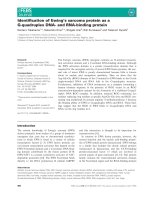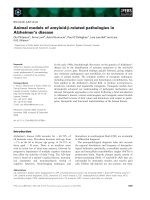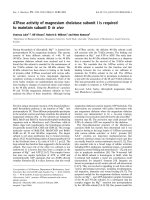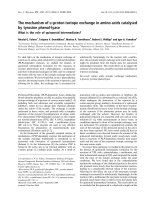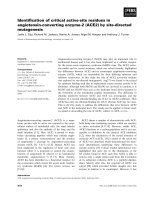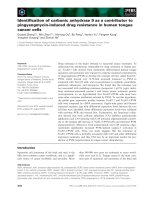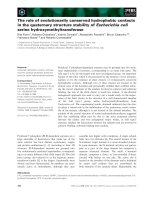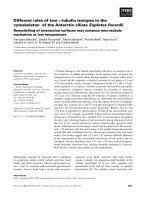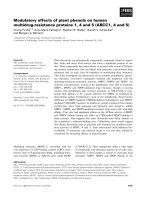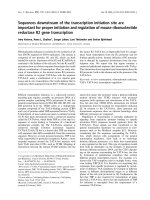Báo cáo khoa học: "Mineral nutrients of beech (Fagus sylvatica) bark in relation to frost sensitivity and soil treatments in southern Sweden" docx
Bạn đang xem bản rút gọn của tài liệu. Xem và tải ngay bản đầy đủ của tài liệu tại đây (87.97 KB, 8 trang )
Original article
Mineral nutrients of beech (Fagus sylvatica) bark
in relation to frost sensitivity and soil treatments
in southern Sweden
Anna Maria Jönsson*
Dept. of Ecology, Forest Ecology, Lund University, Ecology Building, 223 62 Lund, Sweden
(Received 25 May 1999; accepted 16 August 1999)
Abstract – Concentration of nutrients and balance between nutrients in trees can affect tree vitality, and are dependent on soil condi-
tions and atmospheric deposition. The aim of this investigation was to survey the concentration of nutrients in beech bark and to look
for relationships with the frost sensitivity of the bark. Beech trees with bark lesions were compared to undamaged beech trees on five
experimental sites with control plots, plots treated with nitrogen, ash or lime. Trees treated with lime had increased Ca/Al ratio and
decreased concentrations of Mn and B. Negative influence from N fertilization could be traced in the concentration of nutrients in the
bark seven years after treatment, but the absence of new lesions indicated that the vigour of the trees has increased. The frost sensitiv-
ity was correlated to the nutrient content. Trees with lesions had higher concentrations of N and Al, indicating influence of soil
acidity.
index of injury / lime / nitrogen / wood ash
Résumé
– Influence de la composition en éléments minéraux de l’écorce en relation avec les traitements chimiques apportés
au sol sur la sensibilité au froid du hêtre dans le sud de la Suède.
La concentration et l'équilibre des éléments minéraux dans les
arbres peut affecter leur vitalité et sont dépendants des conditions de sol et des dépôts atmosphériques. Le but de ce travail a été
d'étudier la concentration des éléments minéraux dans l'écorce du hêtre et d'essayer de mettre en évidence des relations avec la sensi-
bilité au froid des écorces. Les arbres avec des lésions au niveau de l'écorce étaient comparés avec des arbres indemnes dans cinq
sites expérimentaux comprenant des placettes témoins et des placettes traitées avec apport d'azote, de cendres ou de chaux. Les arbres
traités avec apport de chaux ont vu un accroissement du rapport Ca/Al et une décroissance de la concentration en manganèse et en
bore. Une influence négative de la fertilisation azotée peut être retrouvée sur la concentration en éléments minéraux de l'écorce sept
ans après le traitement. Mais l'absence de nouvelles lésions indique que la vigueur des arbres a été accrue. La sensibilité au froid a été
correlée avec la teneur en éléments minéraux. Les arbres avec des lésions ont présenté une plus grande concentration en azote et en
Al reflétant l'influence de l'acidité du sol.
sensibilité au froid / chaux / azote / cendres
1. INTRODUCTION
Nutrients and their relative proportions to each other
in trees are important for tree vitality. They are influ-
enced by air pollution, nitrogen deposition and soil
acidification. A high deposition of S and N in southern
Swedish beech forests has led to increased forest soil
acidification [30]. The amount of exchangeable Al has
doubled, and the amount of base cations (Ca, Mg, K,
Zn) has decreased on average by 50% during the last 40
years [10]. From an analysis of nutrients in leaves from
beeches grown in Scania it was concluded that many of
Ann. For. Sci. 57 (2000) 1–8 1
© INRA, EDP Sciences 2000
* Correspondence and reprints
Tel. 46 46 222 4247; Fax. 46 46 222 4423; e-mail:
A.M. Jönsson
2
the trees had suboptimal concentrations of K, Mg and P
whereas the N concentration in general was high [3].
The more acid soil, the lower the cation-holding
capacity of the soil particles. In the organic layer the
charges of the cation exchange complexes are pH depen-
dent, and in the mineral soil the cation exchange com-
plexes become increasingly saturated with Al at lower
pH [30]. The solubility of Mn and Fe increases at low
pH and in anaerobic conditions [23]. This increases the
concentration of cations in the water solution, and the
part that is not taken up by the organisms is lost from
the ecosystem by leakage. At the same time, the trees
grow better with an increased N supply, which increases
the uptake of cations and enhances biological soil acidi-
fication [21]. Deficiencies of base cations may arise if
weathering is insufficient to meet nutrient demands [5,
11, 26, 31].
Due to nutrient imbalances, trees subjected to an
increased N supply may become more sensitive to envi-
ronmental stress, for instance frost and drought [21, 24].
Environmental stress changes physiological and chemi-
cal conditions within the trees which predisposes the
trees to lethal attacks by opportunistic pathogenic organ-
isms [33]. A high N level can increase the frequency of
frost injuries in trees through lowered starch concentra-
tion and delayed hardening [8]. Bark lesions caused by
frost injuries are frequently observed on declining oaks,
which together with insect defoliation and drought are
thought to be primary stress factors contributing to oak
decline. Lesions that are not healed are invaded by path-
ogenic insects or fungi [16]. The frost injuries usually
occur late in winter when the trees are not hardened [27].
Lesions on beeches can also be attributed to the beech
bark disease. The disease is initiated by the insect
Cryptococcus fagisuga that is more frequent on beech
stems with high concentrations of amino acids [32].
Trees with N or P in excess or deficiency had increased
sensitivity to the disease and low concentrations of Ca
and Mg in the bark increased the severity of the necrosis
[22].
A lowered N input to forest stands saturated with N
quickly improved the chemical composition of the soil
solution and after some years the trees responded with
increased vigour [6, 7]. Lime has been tested as a
counter measure to soil acidification for many years. Soil
conditions have been improved, acidity and the amount
of free Al ions have been reduced. Wood ash and non-
nitrogenous fertilizers are applied to improve the nutrient
status [9]. Trees have nutrient reserves in the trunk
which are used during the vegetative period, thus soil
treatment is not expected to change their nutrient status
within a short period [14]. The inner bark is composed of
phloem tissue from preceding years, thus the response to
fertilization is lower, but more persistent in bark tissue
than in foliage [29].
The aim of this study was to survey the concentration
of nutrients in beech bark and to evaluate effects of soil
amendments and changes in N input. The aim was also
to correlate the concentration of nutrients to the appear-
ance of bark lesions and frost sensitivity of bark, mea-
sured as an index of injury.
1.1. Hypotheses
1. The nutrient concentration in bark differs from
treatment to treatment. Trees treated with wood ash
or lime were expected to have more base cations
and less Al, Mn and Fe, whereas the situation for
the N-fertilized trees would be reversed;
2. Trees with bark lesions have lower concentrations
of base cations and higher concentrations of N, Al,
Mn and Fe compared to trees with undamaged
bark;
3. Frost sensitivity, measured as an index of injury,
can be related to the nutrient concentration in bark.
2. MATERIAL AND METHODS
Five beech forest sites in southernmost Sweden with
trees approximately 100 years old were investigated in
1997. All experimental sites were designed as ran-
domised blocks with three replicates, except Ynde that
had only two replicates. Each site had control plots and
plots treated with either lime, ash or nitrogen. The sites
had different soil types with a big variation in order to
increase the range of nutrient concentrations, which
would make relationships between nutrient status and
frost hardiness easier to detect.
• Svenstorp, a haplic podzol treated with 5 000 kg lime
ha
–1
in December 1991. The lime contained 45% CaO
and 5% Mg;
• Floen, a cambic podzol also treated with 5 000 kg
lime ha
–1
in December 1991. The lime contained 46%
CaO and 3% Mg;
• Maglehem, a dystric cambisol transitional to cambic
arenosol, fertilised with nitrogen in 1985-1989, 66
and 198 kg NH
4
NO
3
ha
–1
yr
–1
for 5.5 years, in total
150 kg N ha
–1
and 450 kg N ha
–1
respectively. The
fertilizer also contained 4% CaCO
3
, 2% MgCO
3
and
traces of other elements [5];
• Konga, a dystric cambisol, fertilized with 150 kg
(NH
4
)
2
SO
4
ha
–1
yr
–1
, started in 1989 and treated for
three years, in total 450 kg N ha
–1
. In 1991 83 kg
NH
4
H
2
PO
4
-fertilization was added per ha on all plots;
Mineral nutrients of beech bark
3
• Ynde, a cambic podzol in combination with haplic
podzol, was treated in January 1990 with 5 000 kg
bark ash ha
–1
. The ash contained 19% Ca, 28% Mg,
12% K and 4.8% P [13].
The analysis of frost sensitivity was modified after
Thomas and Blank (1996). It was measured in August
since frost injuries often occurs when the trees are not
hardened, and repeated in November when the trees were
hardened. Trees were classed as undamaged or having
bark lesions. Three trees with bark lesions and three
undamaged trees were randomly chosen for both control
and treatment on each site, however, at Maglehem no
control tree with lesions was found. Algae and lichens
were removed from the bark surface on the north side of
the stem with a scraper. Bark samples, mainly phloem
and cambial tissue, were taken approximately 1.3 m
above ground with a hole puncher, 1 cm in diameter. The
samples were kept in plastic test tubes with caps in order
to prevent desiccation and transported in a cool-box to
the laboratory. Bark thickness was measured and the
samples were stored at +5°C until the next morning
when the freezing treatment began.
For each tree three pieces of bark (replicates) were
stored at +5 °C as control and three (+two for the nutri-
ent analysis) were autoclaved for 20 minutes at 120 °C.
Three pieces of bark were exposed to the test tempera-
ture, –10 °C or –20 °C, for 30 minutes. They were then
thawed at +5 °C for 10 hours.
Five mL 3% propanol was added to all bark samples,
and they were incubated in darkness for 24 hours at
25 °C. During that time ions from the bark tissue leaked
into the propanol solution, the larger injury the higher
leakage. The conductivity was measured with a CDM92
conductivity meter (radiometer, Copenhagen), reference
temperature 20 °C. An index of injury ranging from 0 =
no freezing damage to 100 = completely killed by freez-
ing treatment was calculated:
I
t
xm = 100*
(
RC
frozen
– RC
control
)
/
(
1 – RC
control
)
,
x = test temperature, –10 °C or –20 °C,
m = month, August (A) or November (N),
RC = R1/R2,
R1 = conductivity for frozen or control samples/bark
thickness,
R2 = conductivity for autoclaved samples/bark thickness.
N concentration was analysed using the Kjeldahl-
method. ICP-analysis was carried out for Al, B, Ca, Cu,
Fe, K, Mg, Mn, Na, P, S and Zn on two autoclaved bark
pieces taken in August. The propanol extract was
analysed separately, to get a rough estimate of the con-
centration of elements in the cells and in the cell wall, so
that the ions contributing to the conductivity and the
frost tolerance in the cells could be estimated. The
remaining bark was digested in concentrated and hot
HNO
3
before analysis. The concentrations were
expressed as mg/g, and for multiple regression analysis
as mmol/g.
In the text the following definitions were used:
(e) = elements in propanol extract of autoclaved bark,
(b) = elements remaining in bark after propanol
extraction, digested in concentrated and hot HNO
3
,
(s) = the sum of propanol extract and the amount in
remaining in bark after propanol extraction.
The value from the statistical test was given for (s)
when the outcome of the statistical test for elements in
extract (e) and elements bark (b) was equal, and not dif-
ferent from the test of their sum (s).
Statistical tests used: two-way anova, fixed model,
Tukeys posthoc test, t-test, correlations and multiple
regression, backward selection, were calculated in accor-
dance with Sokal and Rohlf (1995). Significances were
indicated with * for the 5% level, ** for the 1% level
and *** for the 0.1% level. The indices of injury from
Svenstorp were omitted from the calculations of multiple
regressions since reliable indices could not be calculated
for four trees with the largest lesions. The conductivities
measured from their bark pieces, subjected to the differ-
ent treatments of an index of injury test, deviated strong-
ly from the general pattern.
3. RESULTS
The mean concentration of nutrients in beech bark for
all sites and treatments are presented in table I. The coef-
ficients of variation were higher for micronutrients and
Al than for macronutrients. More than 50% of Al, B and
K were extracted, but only little of Cu, Ca and S
(table II).
There were a few significant differences in concentra-
tion of nutrients among the control trees at Svenstorp,
Maglehem, Ynde and Floen. The N content was higher
at Svenstorp than at Ynde (F = 10.13**). Compared to
control trees at the other sites, P-fertilized trees at Konga
had lower concentrations of Al (st = –2.671*),
Ca (st = –3.484**), S (bt = –2.997**) and higher con-
centrations of Cu (et = 11.23***), Fe (st = 2.279*),
Mg (bt = 2.353*) (df = 26).
The Mn concentration varied considerably among the
blocks at Ynde and Svenstorp. The four highest Mn con-
centrations were found in trees at Ynde standing in the
block near a wet spot in the forest, the two highest in
the control plot and the 3rd, 4th and 12th ranked in the
treated plot beside it. In the other block the Mn
A.M. Jönsson
4
concentrations were much lower, ranking order 19, 22,
44 respectively 17, 33, 34, 37 of all investigated trees. At
Svenstorp the concentrations of Fe(s) and Mn(s) tended
to be higher in trees standing at the bottom of the slope
near a wet outflow area, than in trees standing in the
middle of the slope. An exception to the general pattern
was one undamaged control tree at the top of the slope
with very high Mn and Fe concentrations (figure 1).
At Svenstorp the amount of B was significantly lower
in trees treated with lime than in untreated trees. Trees
treated with lime at Floen had lower concentration of
Mn, and the Ca/Al ratio was higher. Trees treated with
bark ash did not differ from control trees at Ynde. No
significantly different nutrient concentrations were found
among treatments at Maglehem. Trees fertilized with
nitrogen at Konga had lower concentrations of
extractable Fe and K, and the K/N ratio was lower
(table III).
The control trees with lesions had elevated concentra-
tions of N (
figure 2), Al(b), K(b) and P(b). The same ten-
dencies were found when including all trees in the
calculations, but not as strong. At Svenstorp the dam-
aged stems had higher concentrations of K(s) and
Mg(s), and the K/N ratio was elevated compared to the
undamaged trees. The Mn concentration was significant-
ly lower in trees with lesions (b). At Ynde the trees with
bark lesions had higher concentrations of Al(b), Ca(b),
P(e) and S(b). At Maglehem trees with lesions had lower
concentrations of Ca(e), Fe(b), K(s), Mg(e), Mn(e) and
P(b) (table IV).
The indices of injury (table V) were dependent on 6 to
11 elements and the explanatory level was about 50%,
even in August when the trees were not hardened
(table VI). The N concentration did not influence the
index at all. The standard partial regression coefficients
revealed that Ca(b) and S(b) were the two most
Table I. The sum of mineral nutrients in extract and extracted bark of Fagus sylvatica taken in August from five different sites and
treatments in southern Sweden. Concentrations significantly affected by soil treatment are marked with an *. Mean concentration
(mg/g), standard deviation (sd) and coefficient of variation (cv) are presented.
all sites Svenstorp Floen Maglehem Konga Ynde
n = 60 n = 12 n = 12 n = 12 n = 12 n = 12
mg/g sd cv mg/g sd mg/g sd mg/g sd mg/g sd mg/g sd
Al 0.008 0.005 0.650 0.012 0.005 0.006 0.004 0.004 0.001 0.004 0.002 0.011 0.004
B 0.022 0.024 1.060 *0.018 0.015 0.024 0.029 0.014 0.024 0.033 0.033 0.022 0.007
Ca 21.368 7.879 0.370 19.922 6.430 21.346 6.387 29.808 7.060 12.412 1.990 23.353 5.021
Cu 0.003 0.002 0.560 0.004 0.002 0.003 0.002 0.003 0.002 0.003 0.001 0.002 0.001
Fe 0.008 0.008 1.070 0.012 0.008 0.007 0.006 0.005 0.009 *0.012 0.010 0.003 0.003
K 3.010 0.756 0.250 2.759 0.790 3.057 0.832 3.073 0.480 *2.697 0.630 3.467 0.846
Mg 0.755 0.225 0.300 0.728 0.230 0.664 0.194 0.657 0.132 0.917 0.247 0.808 0.222
Mn 1.038 0.493 0.480 1.094 0.363 *0.803 0.351 0.619 0.228 1.212 0.331 1.460 0.638
N 6.096 1.040 0.170 7.013 1.512 6.105 0.595 5.511 0.590 6.398 0.762 5.453 0.628
Na 0.014 0.017 1.180 0.026 0.018 0.008 0.008 0.013 0.013 0.014 0.026 0.009 0.008
P 0.390 0.086 0.220 0.360 0.073 0.387 0.065 0.389 0.067 0.357 0.061 0.455 0.122
S 0.835 0.174 0.210 0.782 0.120 0.767 0.138 0.962 0.137 0.655 0.068 1.010 0.102
Zn 0.020 0.024 1.200 0.018 0.012 0.016 0.012 0.010 0.009 0.013 0.007 0.043 0.044
Table II. Average percentage of elements in bark able to be
extracted with 3% propanol solution after autoclaving (n = 60).
%%
Al 67 Mg 18
B61Mn11
Ca 2 Na 18
Cu 8 P 33
Fe 31 S 7
K 63 Zn 48
Table III. Elements significantly affected by the soil treatment.
The %-value indicates the difference between the mean con-
centration in treated trees compared to the mean concentration
in control trees.
site element F-value %
Svenstorp B(s) 5.299* –62
Floen Mn(s) 29.4*** –53
Floen Ca/Al 5.791* +47
Konga Fe(e) 13.656** –35
Konga K(e) 9.526* –24
Konga K/N 5.999* –21
Mineral nutrients of beech bark
5
important elements in all equations, except I
t
20A. Trees
with relatively high Ca and low S concentrations were
less damaged and had hardened better. The conductivity
of autoclaved samples (AC) was up to 82% explained by
the following model, derived from multiple regression:
AC =
c + c
1
K(e) + c
2
Mg(e) + c
3
S(e) + c
4
Al(e) (F =
48.2***) (c = constant).
4. DISCUSSION
The nutrient levels in the bark of control trees did not
differ much at the different sites, despite differing soil
conditions and exposure to deposition. There might be a
large variation in the concentration of elements between
trees of one species, but the concentrations are within the
Figure 1. At Svenstorp the experimental plots were situated on rather a steep slope, about 20 m in length. The position on the terrain
influenced the concentration of Mn and Fe in the trees. Standard deviations are indicated on the bars,
n = 12.
Figure 2. N concentrations (mg/g) for control trees at Floen
(FL), Maglehem (MA), Svenstorp (SV) and Ynde (YN), and
for P fertilized trees at Konga (KO). Trees with bark lesions
had elevated N concentration compared to trees with undam-
aged stems. There was no control tree with bark lesion at
Maglehem. Standard deviation is indicated by a line on top of
each bar.
Table IV. The concentration of elements differed somewhat
between trees with bark lesions and trees with undamaged
stems. The %-value indicates the difference between the mean
concentration in trees with lesions compared to the mean con-
centration in trees with undamaged stems.
site element F-value %
all controll N 5.06* +7
" Al (b) 10.26** +200
" K(b) 8.22* +26
" P(b) 8.60* +16
Svenstorp K(s) 10.369** +49
" Mg(s) 10.24** +57
" Mn(b) 10.13** –38
" K/N 5.532* +29
Ynde Al(b) 11.621** +400
" Ca(b) 8.273* +35
" P(e) 5.901* +43
" S(b) 11.289** +14
Maglehem Ca(e) 9.357* –18
" Fe(b) 5.163* –83
" K(s) 17.492** –8
" Mg(e) 6.453* –35
" Mn(e) 7.868* –51
" P(b) 5.292* –3
A.M. Jönsson
6
ranges that are typical for each tree species [15]. The
nutrient concentrations in xylem sap varies from season
to season. It is lowest during the summer when the nutri-
ent reserves are used and increases in late autumn when
the leaves are shed [14]. Thus, the concentration of nutri-
ents were analysed in August when it was expected that
deficiency or excess of any element would be most pro-
nounced. N was the least variable element, and this has
also been recorded for beech leaves [3]. The reason
would be that availability of N regulates growth.
Concentrations of macronutrients were less variable than
concentrations of micronutrients, probably due to analy-
sis sensitivity and because contamination makes a larger
difference to nutrients in low concentrations. The con-
centrations of Mn and Fe in the trees were more influ-
enced by a high water table than acid soil conditions.
Anaerobic conditions can damage the roots and cause
lesions and both at Svenstorp and Ynde, dead and badly
damaged trees were observed on the wet spots. The Al
concentration in bark can be expected to reflect the acidi-
ty of the soil, since Al is not taken up by the trees as a
nutrient. Compared to the concentration of nutrients in
leaves from beeches grown in southern Sweden [3] the
concentration of Ca was three times higher in the bark
tissue. The concentration of other elements were 2–3
times lower in bark tissue than in leaves. This reflects
the supportive function of the bark tissue with thicker
cell walls and much lower photosynthetic capacity than
the leaves. The same pattern was found for white spruce
[29], and for several tree species in a montane rain forest
in New Guinea [15].
Complex forming metals, such as Cu and Mn, bind
strongly to cellulose and hemicellulose and cell wall
proteins contain S [19], thus those elements showed low
solubility in propanol solution. The sum of mineral nutri-
ents in propanol extract (e) and nitric acid digest (b) is
fairly comparable to the concentrations in bark samples
digested in nitric acid only (= unextracted). Only the
concentrations of Cu and Na did not correlate between
extracted and unextracted samples (Jönsson unpubl.). Na
is, in any case, not considered an essential element for
plants [19].
At Floen the lime treatment had positive effects on the
bark chemistry, with decreased Mn concentration and
elevated Ca/Al ratio. Liming could decrease the uptake
of B, K and P in trees, especially at high doses [2, 17,
18]. A lower concentration of B was found in the bark of
trees treated with lime at Svenstorp, whereas the K and P
concentrations were neither affected at Svenstorp nor at
Floen. Liming reduces negative effects of soil acidifica-
tion, but missing nutrients other than Ca and Mg must be
supplied by other means, for instance by treatment with
wood ash. In this study, however, the levels of bark
nutrients were not significantly affected by ash treat-
ment. The base saturation of the soil had increased in
1995, mostly in the mor layer but also in the mineral
horizon [13]. There is a time delay between soil treat-
ment and tree response [14], so perhaps the nutrient sta-
tus within the trees will be affected in the future.
During the N-fertilization in Maglehem strong acidifi-
cation, leaching of NO
3
–
and cations together with mobi-
lization of Al and Mn were recorded in the soil [5]. In
the leaves of fertilized trees the concentrations of total N
and amino acids were elevated, and the concentrations of
P, Cu and phenolic compounds were lowered [4]. Old
bark lesions were visible on the fertilized trees, but not
on the control trees. The bark nutrient composition did
not differ significantly among the different treatments
seven years after the N-fertilization, but the trees with
bark lesions had lower concentrations of mineral
Table V. Mean value and standard deviation for the index of
injury, a measure of frost sensitivity in beech bark, on the five
sites in August
(
I
t
×A
)
and November
(
I
t
×N
)
(n = 56).
mean SD
I
t
10A 61.0 16
I
t
20A 69.5 18
I
t
10N 6.7 10
I
t
20N 19.0 11
Table VI. Models for index of injury, produced by stepwise multiple regression of nutrients in bark extract (e) and extracted bark tis-
sue (b). The elements are ranked in importance according to the standard partial regression coefficient. Values from treated and con-
trol plots at Floen, Konga, Maglehem and Ynde, c = constant (n = 48).
Index Included elements r
2
df F
I
t
10A c (S(b), Ca(b), P(b), Zn(b), Na(e), Cu(e)) 0.46 6 5.74***
I
t
20A c (S(e), Fe(b), Cu(b), Ca(b), Mg(e), B(b), K(b), P(e)) 0.58 8 6.76***
I
t
10N c (Ca(b), S(b), Mg(b), Mg(e), Mn(e), Al(b), K(b), Cu(e), Fe(b)) 0.58 9 5.76***
I
t
20N c (Ca(b), S(b), Fe(e), Mn(b), Fe(b), P(b), Na(e), Cu(e)) 0.41 8 3.42**
Mineral nutrients of beech bark
7
nutrients. The phloem tissue formed during the treatment
was affected by the lowered soil concentrations of nutri-
ents, and the trees most affected developed bark lesions.
Since no new bark lesions were observed, this suggests
that the negative effects of excessive N can be reversed
if the load is removed. However, this, together with the
lower K concentration and K/N ratio in the bark of N
fertilized trees at Konga, indicated that nutrient depletion
has long-lasting impacts on the forest ecosystem.
Conifers growing at N-saturated sites showed signs of
improved nutrient balance after 3–4 years with the con-
centration of N in the throughfall water reduced to a pre-
industrial level [6, 7]. Calcium phosphate and aluminium
phosphate were probably formed in the soil as a response
to the addition of P, and these low soluble complexes
reduced the uptake of Ca and Al in the trees. This has
been recorded for Al in beech seedlings [18].
Differences between undamaged trees and trees with
lesions partly supported the second hypothesis. Higher
concentrations of N and Al were found in trees with
lesions, but lower concentration of base cations were
only found at Maglehem. At Ynde the bark lesions were
associated with a high Al concentration. At Maglehem
the effects of the N fertilization were apparent. Also at
Svenstorp, Floen and Konga bark lesions were associat-
ed with elevated N concentration (figure 2). The differ-
ence between trees with bark lesion and trees with
undamaged stems was statistically significant only when
all sites were analysed together, since the variation in
concentration of N was low among the trees. A tree with
lesions will allocate resources to the bark in order to
repair the damage [20]. High concentration of Ca, K, Mg
and P can reduce Al toxicity [1], and the elevated con-
centrations of these elements in trees with bark lesions
indicated repairing processes. Approximately 98% of the
Ca content is located in the cell walls, as indicated by
extraction with propanol solution. Ca stabilises the cell
walls [19], and high levels of Ca may therefore reduce
the severity of the necrosis as observed by Perrin and
Garbaye (1984).
Frost sensitivity was correlated to the nutrient concen-
trations. The nutrient concentrations have impact on the
concentrations of carbohydrates, amino acids and fatty
acid composition of membranes as well as the onset of
hardening, all important for frost resistance [12]. Low
levels of Ca in combination with high levels of S could
be expected to occur on acid soils exposed to high depo-
sition of N and S.
I
t
20A was the most severe treatment
with low temperature and unhardened bark, and it is
worth noting that the concentration of Ca(b) was not as
important as in the multiple regressions of the other
indices. The concentration of N was not incorporated in
the multiple regressions, since the variation among the
trees was low. Although the extractable concentrations
of K, Mg, S and Al were strongly correlated to the con-
ductivities of autoclaved samples, they were not impor-
tant in the correlation to the indices of injury. To be able
to fully understand the importance of nutrient balance for
frost sensitivity controlled greenhouse experiments
should be carried out.
4.1. Conclusions
Trees with bark lesions had higher concentrations of
N and Al, as well as elements connected to repairing
processes. Locally, a high water table had a strong influ-
ence on the concentrations of Mn and Fe in bark. Liming
reduced negative effects of soil acidification in the bark
chemistry. Negative influence from N fertilization could
be traced in the concentration of nutrients in the bark,
but the absence of new lesions indicated that the vigour
of the trees has increased during the seven years since
last N fertilization. Differences in frost sensitivity
between trees in southern Sweden can be attributed to
differences in nutrient concentrations.
Other studies on the same sites have considered the
influence of soil treatment and soil parameters on frost
sensitivity (Jönsson, in press).
Acknowledgements: I am grateful to Professor Bengt
Nihlgård for support during the study. I thank Irene
Persson, Siv Billberg and Maj-Lis Gernersson, who per-
formed the chemical analysis, and Abigail Sykes, who
revised the language. This study was financially support-
ed by the Swedish MISTRA foundation.
REFERENCES
[1] Andersson M., Toxicity and tolerance of aluminium in
vascular plants, Water Air Soil Pollut. 39 (1988) 439-462.
[2] Aronsson A., Indikationer på stress vid obalans i trädens
växtnäringsinnehåll, K. Skogs- o. Lantbr.akad. tidskr. Suppl.
17 (1985) 40-51 (in Swedish).
[3] Balsberg Påhlsson A M., Mineral nutrients, carbohy-
drates and phenolic compounds in leaves of beech (
Fagus
sylvatica
L.) in southern Sweden as related to environmental
factors, Tree Physiol. 5 (1989) 485-495.
[4] Balsberg Påhlsson A M., Influence of nitrogen fertiliza-
tion on minerals, carbohydrates, amino acids and phenolic
compounds in beech (
Fagus sylvatica L.) leaves, Tree Physiol.
10 (1992) 93-100.
[5] Bergkvist B., Folkesson L., Soil acidification and ele-
ment fluxes of a
Fagus sylvatica forest as influenced by simu-
lated nitrogen deposition, Water Air Soil Pollut. 65 (1992) 111-
133.
A.M. Jönsson
8
[6] Boxman A., Van der Ven P., Roelofs J., Ecosystem
recovery after a decrease in nitrogen input to a Scots pine stand
at Ysselsteyn, the Netherlands, For. Ecol. Manag. 101 (1998)
155-163.
[7] Bredemeier M., Blanck K., Dohrenbusch A., Lamersdorf
N., Meyer A.C., Murach D., Parth A., Xu Y J., The Solling
roof project – site characteristics, experiments and results, For.
Ecol. Manag. 101 (1998) 281-293.
[8] Burke M.K., Raynal D.J., Mitchell M.J., Soil nitrogen
availability influences seasonal carbon allocation patterns in
sugar maple (Acer saccharum), Can. J. For. Res. 22 (1992)
447-456.
[9] Evers F.H., Hüttl R.F., A new fertilization strategy in
declining forests, Water Air Soil Pollut. 54 (1990/91) 495-508.
[10] Falkengren-Grerup U., Eriksson H., Changes in soil,
vegetation and forest yield between 1947 and 1988 in beech
and oak sites of southern Sweden, For. Ecol. Manag. 38 (1990)
37-53.
[11] Falkengren-Grerup U., Tyler G., Changes of cation
pools of the topsoil in south Swedish beech forests between
1979 and 1989, Scand. J. For. Res. 6 (1991) 145-152.
[12] Fitter A.H., Hay R.K.M., Environmental physiology of
plants, 2 ed. Academic press, London, ISBN 0-12-257764-7,
1993.
[13] Fransman B., Bramryd T., Barkaska som vitaliser-
ingsmedel i samband med bokföryngring. Ynde-projektet,
Ekol. inst. University of Lund. (In Swedish) 1996.
[14] Glavac V., Koenies H., Ebben U., Seasonal variations
in mineral concentrations in the trunk xylem sap of beech
(
Fagus sylvatica L.) in a 42-year-old beech forest stand, New
Phytol. 116 (1990) 47-54.
[15] Grubb P.J., Edwards P.J., Studies of mineral cycling in
a montane rain forest in New Guinea, J. Ecol. 70 (1982) 623-
648.
[16] Hartmann G., Blank R., Etiology of oak decline in
northern Germany. History, symptoms, biotic and climatic pre-
disposition, pathology, in: Luisi N., Lerario P. and Vannini A
(Eds.), Recent advances in studies on oak decline,
Tipolitografia radio, Putignano Baic, ISBN 88-86337-00-0,
1993.
[17] Liljelund L E., Nihlgård B., in: Andersson F. and
Persson T. (Eds.) Liming as a measure to improve soil and tree
condition in areas affected by air pollution, Swedish
Environmental Protection Agency report 3518, 1988.
[18] Ljungström M. and Nihlgård B., Effects of lime and
phosphate additions on nutrient status and growth of beech
(
Fagus sylvatica L.) seedlings, For. Ecol. Manag. 74 (1995)
133-148.
[19] Marschner H., Mineral nutrition of higher plants,
Academic press, Belfast, ISBN 0-12-473540-1, 1986.
[20] McLaughlin S.B., Shriner D.S., Allocation of resources
to defence and repair, in: Horsfall J.G. and Cowling E.B.
(Eds.), Plant disease, Vol. V. Academic Press, New York,
ISBN 0-12-356405-0, 1980.
[21] Nihlgård B., Forest decline and environmental stress,
in: Brune D., Chapman D.V., Gwynne M.D. and Pacyna J.M.
(Eds.), The global environment; science, technology and man-
agement, Scandinavia Science Publ., Oslo, ISBN 3-527-28771-
x. 1997.
[22] Perrin R., Garbaye J., Influence de la nutrition de hêtre
(
Fagus sylvatica L.) sur la sensibilité au chancre provoqué par
Nectria ditissima Tul., Ann. Sci. For. 41 (1984) 449-460 (in
French).
[23] Scheffer, Schachtschabel P., Lehrbuch der
Bodenkunde. 12ed., Ferdinand Enke Verlag, Stuttgart, ISBN 3
432 84772 6, 1989.
[24] Skeffington R.A., Wilson E.J., Excess nitrogen deposi-
tion: Issues for consideration, Environ. Pollut. 54 (1988) 159-
184.
[25] Sokal R.R., Rohlf F.J., Biometry. 3ed., Freeman and
Company, New York, ISBN 0-7167-2411-1, 1995.
[26] Sverdrup H., Warfvinge P., Critical loads of acidity for
Swedish forest ecosystems, Ecol. Bull. 44 (1995) 75-89.
[27] Thomas F.M., Büttner G., Excess nitrogen, drought,
and winter frost as possible predisposing factors of oak decline
in northern Germany, in: Luisi N., Lerario P. and Vannini A.
(Eds.), Recent advances in studies on oak decline,
Tipolitografia radio, Putignano Baic, ISBN 88-86337-00-0,
1993.
[28] Thomas F.M., Blank R., The effect of excess nitrogen
and of insect defoliation on the frost hardiness of bark tissue of
adult oaks, Ann. Sci. For. 53 (1996) 395-406.
[29] Timmer V.R., Effect of fertilization on nutrient concen-
trations of white spruce foliage and bark, For. Sci. 25 (1979)
115-119.
[30] Tyler G., Acidification and Chemical Properties of
Fagus sylvatica L. Forest Soils, Scand. J. For. Res. 2 (1987)
263-271.
[31] Ulrich B., Soil acidity and its relations to acid deposi-
tion, in: Ulrich B. and Pankrath J.D. (Eds.), Effects of accumu-
lation of air pollution in forest ecosystems, Reidel Publ. Co.,
Dortrecht, 1983.
[32] Wargo P.M., Amino nitrogen and phenolic constituents
of bark of American beech (
Fagus grandifolia) and infestation
by beech scale (
Cryptococcus fagisuga), Eur. J. For. Pathol. 18
(1988) 279-290.
[33] Wargo P.M., Consequences of environmental stress on
oak: predisposition to pathogens, Ann. Sci. For. 53 (1996) 359-
368.
